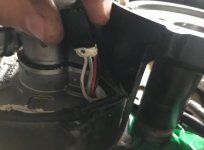Cyclomania
10 kW
So I have been thinking about potentially overvolting the bbs02 with a new controller. Any idea how much it can take?
I was thinking like maybe using like a max current controller of 45a. But maybe this is way too much for it to handle? It might only be able to take like max current of 30 or something like that?
Also, any ideas what universal controllers might work with the bbs02 750watt 48vot motor? Kunteng or something like that.
I have opened it and I can clearly see hall sensors and phase. But I am not sure what this is in the picture. Is that perhaps throttle? Looks a bit weird since throttle wires usually have three wires. So not sure how to connect this one an to what. But phase wires there are three and hall the normal connection of five so those probably wont be a problem to connect.
I was thinking like maybe using like a max current controller of 45a. But maybe this is way too much for it to handle? It might only be able to take like max current of 30 or something like that?
Also, any ideas what universal controllers might work with the bbs02 750watt 48vot motor? Kunteng or something like that.
I have opened it and I can clearly see hall sensors and phase. But I am not sure what this is in the picture. Is that perhaps throttle? Looks a bit weird since throttle wires usually have three wires. So not sure how to connect this one an to what. But phase wires there are three and hall the normal connection of five so those probably wont be a problem to connect.




